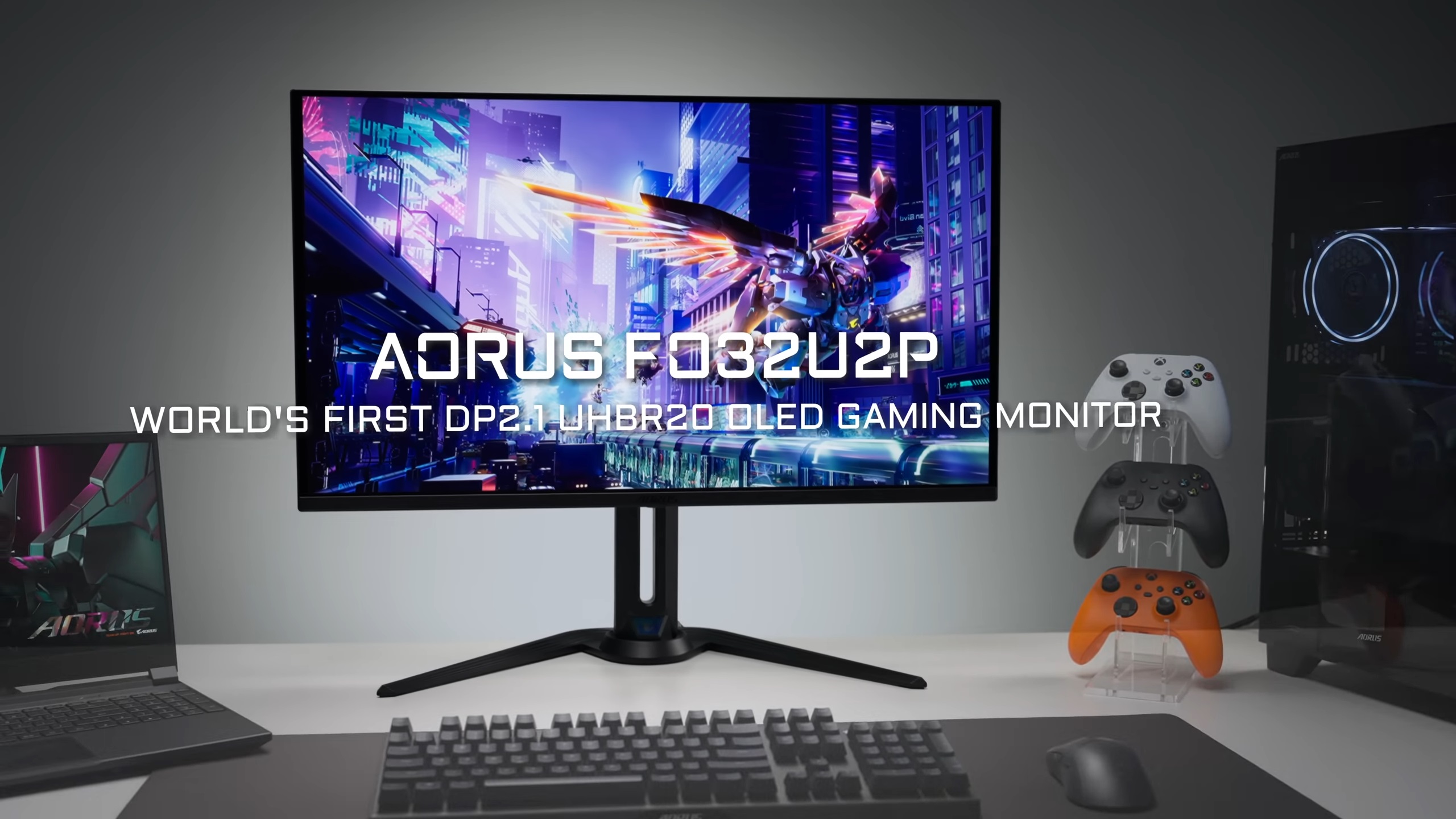Gigabyte unveils a big gaming OLED monitor with a steller refresh rate — Aorus FO32U2P flaunts 4K, 240 Hz panel with DisplayPort 2.1 and UHBR 20 support
With ultra-high bitrates of up to 80 Gb/s, the Aorus FO32UP should have plenty of bandwidth to provide the best possible display... on paper!

Like many companies, Gigabyte showed off its upcoming monitors during CES 2024, ready to release anything this year. The company showcased five monitors, but the Aorus FO32UP is its first monitor to use DisplayPort 2.1 and UHBR (Ulta High Bitrate) 20 standard for its QD-OLED monitor.
This standard means that this monitor will have a transfer speed of 20 Gbit/s with each of its four lanes, giving you up to 80 Gbit/s without Display Stream Compression. Theoretically, it should provide enough bandwidth for a better gaming visual experience than the UHBR1.3-certified monitors. The DP 2.1 standard can also support daisy chaining between multiple displays, reducing the clutter between the system and various monitors. AMD Radeon RX 7000 series already supports DP 2.1 with UHBR 13.5, and the next generation Nvidia RTX Blackwell 50 series is rumored to support DisplayPort 2.1. We'll have to see if Blackwell GPUs will support UHBR20.
The FO32U2P is a 32-inch QD-OLED monitor with 4K resolution and 240 Hz refresh rate. The panel is rated for VESA ClearMR 13000, VESA DisplayHDR True Black 400, and 99% DCI-P3 ultrawide color gamut.
2024 is the Year for HDMI 2.1, DisplayPort 2.1 and Dual Resolution Toggle Monitors
All this sounds good on paper, but Aorus, like everybody else, will have to show it takes advantage of this increased bandwidth to provide the best possible display performance. We'll only know that once the monitor is released and if we can test it. Many monitors were down during CES 2024 with DisplayPort 2.1, such as the ROG Swift PG32UQXR monitor, with 4K resolution on a 32-inch display and DisplayPort2.1 and HDMI 2.1 output.
Like the Asus PG32UCDP monitor, this monitor will let you toggle with a 1080p resolution, which Gigabyte calls 'Resolution Switch,' letting you play games on your preferred resolution. It is not known what the accompanying refresh rate for the 1080p mode will be. The Asus PG32UCDP switches to 1080p with a 480 Hz refresh rate. This Asus monitor offers DisplayPort 1.4 and HDMI 2.1, just like the Aorus FO32U2 showcased during CES 2024.
It is no surprise that monitors are adopting newer standards. As said before, it will be a while since we see DisplayPort 1.2a being adopted by both display and GPU vendors. Gigabyte did not reveal its pricing, but it is expected to be out within 1st Half of 2024, perhaps along with the Aorus FO32U2.
Get Tom's Hardware's best news and in-depth reviews, straight to your inbox.

Roshan Ashraf Shaikh has been in the Indian PC hardware community since the early 2000s and has been building PCs, contributing to many Indian tech forums, & blogs. He operated Hardware BBQ for 11 years and wrote news for eTeknix & TweakTown before joining Tom's Hardware team. Besides tech, he is interested in fighting games, movies, anime, and mechanical watches.
-
ILuvNats I want a 48" - 55" monitor at 8K for software development, to be able to see a lot of text very sharply. I don't care if it won't game, at that size it can be used at 4K just fine. But the big ticket would be 8K, with a lot of CPU RAM and the like. Have wanted one of these for several years. I have a 4K Dell 43" but want sharper (scaled) text, and slightly bigger font size for easier reading. This 43" is a bit smaller than the dual 1080 monitors we get at work, kind of like going from 11 pt in Word to 10 pt; 48"-50" would be the same text size. At 8K I'd just run it at 60 Hz for non game use.Reply -
scottsoapbox Embarrassing number of typos in this article.Reply
At least try to get the version numbers being compared right. -
The Historical Fidelity Reply
Agreed, the article says “DisplayPort 1.2a” instead of 2.1ascottsoapbox said:Embarrassing number of typos in this article.
At least try to get the version numbers being compared right. -
Tom Sunday I love the thought or even owning one of the newly proffered big gaming OLED monitors. For that matter I understand that the recent CES was actually brimming with the introduction of new monitors and that the OEMs are now banking on new and big money making opportunities from just this product alone. There was even marketing-talk and that people used to replace their monitor every 5-years or so and that this now reduced itself downwards to 3-years. Thus new quick sales opportunities abounding!Reply
But the new UHD OLED or 4K monitors come with a catch: Anyone who has been stuck with Full HD or Wide QHD and is now thinking about moving into higher-resolutions must pay attention to the additional need for increased image sharpness if the FPS is to remain high. Relative pixel increases may quickly reach critical overheating ranges - even when upgrading from Wide QHD to Ultra HD. Simply put the computational demands on the GPUs almost double – so that a 'base-level' GeForce, Arc or Radeon’s will work up a considerable sweat.” In short…buying a new 2024 display by itself is now not enough, and much deeper pockets for additional and beefier associated hardware will have too be on the Santa list! I also wondered what happened earlier with all the talk about HDR10? At CES that subject was seemingly ignored and downplayed? Will I personally be delighted with a refresh rate of a 240 Hz panel and will it dramatically improve the replacing of my roofs in Sanctuary? Or better defeating the Nazi’s in Wolfenstein on the train to Berlin? I doubt it!
